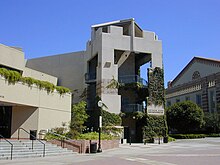Arthur Ashe
On June 20, 1993, he was posthumously awarded the Presidential Medal of Freedom by United States President Bill Clinton.
The Arthur Ashe Stadium, the main court for the US Open and the largest tennis arena in the world, is named in his honor.
[11] The brothers were born into a family that claimed direct descent from Amar, a West African woman who was enslaved and brought to America in 1735 aboard a ship called The Doddington.
[14] Ashe and his brother were raised by their father, who worked as a handyman and salaried caretaker/Special Policeman for Richmond's recreation department.
Ashe attended Maggie L. Walker High School in Richmond, Virginia, where he continued to practice tennis.
Ron Charity brought him to the attention of Robert Walter Johnson, a physician, and the coach of Althea Gibson, who founded and funded the Junior Development Program of the American Tennis Association (ATA).
In 1960, Ashe was precluded from competing against White youths in segregated Richmond during the school year, and unable to use the city's indoor courts that were closed to Black players.
Ashe was able to practice at the National Guard Armory indoor courts and in 1961, after lobbying by Johnson, was granted permission to compete in the previously segregated U.S. Interscholastic tournament and won it for the school.
During his time at UCLA, he was coached by J. D. Morgan and practiced regularly with his sporting idol, Pancho Gonzales, who lived nearby and helped hone his game.
Ashe was also a member of the ROTC, which required him to enter active military service after graduation in exchange for money for tuition.
[17][18] In 1961, Ashe won the Eastern Clay Court Championships defeating George Ball and Bob Barker in close five set matches in the semifinal and final.
In 1963, Ashe won the Pacific Southwest Championships in Los Angeles on concrete defeating Rafael Osuna and Whitney Reed in the final two rounds.
The following season he won the 1964 Eastern Grass Court Championships at South Orange, New Jersey defeating Dennis Ralston, Gene Scott, and Clark Graebner in close matches.
Because of this, he could not accept the $14,000 first-prize money, which was instead given to runner-up Tom Okker,[20] while Ashe received just $20 daily expenses for his historic triumph.
His only loss in the 12 Davis Cup tournament singles matches he played that year, was in the last dead rubber game after the U.S. team had already clinched victory.
In March 1970, triggered by South Africa's refusal to grant Ashe a visa to play there, the country was expelled from the Davis Cup competition for its racial policy.
Ashe then turned professional, signing a five-year contract with Lamar Hunt's World Championship Tennis.
Commentators considered that the boycott demonstrated the power of the fledgling ATP, and showed the tennis associations that professional players could no longer be dictated to.
[24] In the media, Ashe called for South Africa to be expelled from the professional tennis circuit and Davis Cup competition.
Ashe played for a few more years and won the Australian Open doubles with Tony Roche in January 1977, but a left foot heel injury requiring surgery a month later and subsequent long-term rehabilitation saw his world ranking drop to a lowly 257th before a remarkable comeback saw him rise back to 13th in the world again the following year at the age of 35.
After his retirement, Ashe took on many roles, including writing for Time magazine and The Washington Post, commentating for ABC Sports and HBO from the early 1980s until a few months before his death, founding the National Junior Tennis League, and serving as captain of the U.S. Davis Cup team from 1981 to 1985.
In 1983, he joined with Harry Belafonte to form the group Artists and Athletes Against Apartheid, which called for a cultural boycott of South Africa.
Six year later, he joined musician and producer Quincy Jones as part of a delegation of 31 prominent African Americans who visited South Africa in 1991 to observe political change in the country as it approached racial integration.
[30] In 1988, Ashe published a three-volume book titled A Hard Road to Glory: A History of the African-American Athlete,[31] after working with a team of researchers for nearly six years.
He also fielded questions about his own diagnosis and attempted to clear up the misconception that only homosexual and bisexual men or IV drug users were at risk for contracting HIV.
In October 1976, Ashe met photographer and graphic artist Jeanne Moutoussamy at a United Negro College Fund benefit.
After undergoing exploratory brain surgery and a number of tests, doctors discovered that he had toxoplasmosis, a parasitic disease that is commonly found in people infected with HIV.
Ashe decided to preempt USA Today's plans to publish the story about his illness and, on April 8, 1992, publicly announced he had contracted HIV.
After the announcement, hundreds of readers called or wrote letters to USA Today criticizing their choice to run the story about Ashe that forced him to publicize his illness.
[citation needed] He is one of only two men of black African ancestry to win any Grand Slam singles title, the other being France's Yannick Noah, who won the French Open in 1983.




